Posted by Elena del Valle on October 9, 2007

Journalist María Elvira Salazar hosts “María Elvira Live”
Photo: Spanish Broadcasting System (SBS)
In an effort to reach a wider and more diverse audience, Spanish Broadcasting System (SBS) launched a nightly news magazine program on its Miami station Mega TV Channel 22. Hosted by journalist María Elvira Salazar, “María Elvira Live” airs weekdays at 8 pm.
Producers promise to feature sophisticated television technology, cutting edge graphics and visuals while highlighting “Salazar’s energetic and animated personality.” Show segments in “María Elvira Live” are: leading news stories of the day including in-studio discussions among guests; “Fuente Confidencial” featuring unconfirmed news; “Sin Anestesia,” Salazar’s one-minute editorial opinions on breaking news; “Fuera de Foco,” Salazar’s opinions on politically incorrect comments from on-air personalities; “Tiro al Blanco con Urdaneta,” a bi-weekly, political satire presented by Orlando Urdaneta, a humorist and actor; and “In Fraganti,” where the audience is invited to be reporters for “María Elvira Live” by sending in their own photos, videos, complaints and opinions.
Listen to Cesar Melgoza discuss
“Changing Latino Landscape” audio recording

Presenter Cesar Melgoza, managing director, Latin Force Group
Find out about
• How demographic, social, political and economic factors affect Latinos
• Number of Hispanics in U.S.
• Hispanics as a percent of the mainstream population
• Number of Puerto Ricans in Puerto Rico
• Hispanics, including Puerto Rico, as a percent of U.S. mainstream
• Number of Asians and African Americans
• Estimated size of Hispanic market by 2012
• Percentage growth of new Hispanics per year
• Number of counties where Latinos are majority
• Areas of significant Latino growth
• Area of U.S. with a 950 percent Latino growth
• Role of acculturation
• Hispanicity segmentation
Click here for information on the Changing Latino Landscape
Salazar has worked in journalism for 22 years and received several Emmy awards. She worked as a news anchor, as a war correspondent for El Salvador’s 12-year civil conflict, and as a White House correspondent. Prior to joining SBS, she worked with CNN en Español, Telemundo and Univision and hosted her own debate show, “María Elvira Confronta.”
Salazar has interviewed political and public figures, including Presidents Bill Clinton and George Bush. In 1996, she was the first Spanish-language U.S-based television reporter to obtain a one-on-one interview with Cuban leader Fidel Castro. In 2003, she interviewed Chilean President Augusto Pinochet.
A Cuban-American, Salazar was raised between Puerto Rico and Miami. She holds a Masters Degree in Public Administration from the Harvard University’s John F. Kennedy School of Government. She began her broadcast career in 1983 as a reporter for Channel 23 in Miami.
Spanish Broadcasting System, Inc. is one of the largest publicly traded Hispanic-controlled media and entertainment companies in the United States. SBS owns and operates 20 radio stations located in New York, Los Angeles, Miami, Chicago, San Francisco and Puerto Rico. The Company also owns and operates Mega TV in Miami.
Comments:
Filed Under: Media
Posted by Elena del Valle on October 8, 2007

DeSoL’s “On My Way” album
Photo: DeSoL
Latin Rockers deSoL’s recently released album “On My Way” blends English and Spanish rock and Latin rhythms. The new CD from Asbury Park’s deSoL is described in promotional materials as “a spiritually charged musical journey that reverberates the confidence of a band that knows exactly where they are going and has just what it takes to get them there.” DeSoL was released through saZon Records/Two22 Music with distribution through ADA.
Over the course of their six years together, deSoL has toured extensively and shared marquees with R.E.M., The Legendary Wailers, Los Lonely Boys, Blues Traveler, Particle and Widespread Panic at Bonnaroo, Lollapalooza, and Austin City Limits.
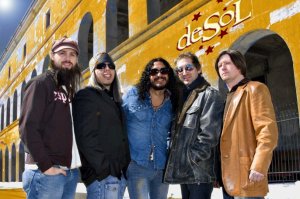
deSoL
The band’s first single, “Karma,” released in 2005, became a Top 5 hit on the AAA radio format. DeSol has Puerto Rican, Salvadorian, and Mexican influences and the band members’ musical heroes include Fania All Stars, Tito Puente, Buena Vista Social Club, Los Lobos, and Santana.
Just before going into the studio to record “On My Way,” deSoL spent a month in the Middle East under contract by the Department of Defense’s Armed Forces Entertainment program. They entertained the men and women of the U.S. troops stationed in Bahrain, Qatar, Djibouti, and Kuwait.
“We’ve been together for more than six years now and the musical and spiritual bonds between the band members just keeps growing stronger all the time,” said Albie Monterrosa, vocalist and guitarist of deSol.
“A Snapshot of the U.S. Hispanic Market” audio recording
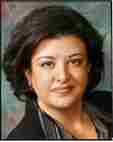
Presenter Michele Valdovinos, Phoenix Cultural Access Group
Click here for information on “A Snapshot of the U.S. Hispanic Market”
Click the button to hear the song Sing It All Night Long:
Posted by Elena del Valle on October 5, 2007
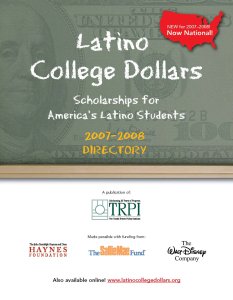
Latino College Dollars Scholarship Directory
Photo: Tomas Rivera Policy Institute
The Tomas Rivera Policy Institute (TRPI) recently expanded its Latino College Dollars Scholarship Directory, available online and in print, with national scholarship information for students. Response to the organization’s first Latino scholarship published last year prompted the Institute to produce a national guide in 2007. Last year’s directory of California scholarships was viewed online an average of 7,000 times a month.
The 2007 directory contains 84 pages of information including 62 pages on 329 scholarships available to Latino high school, undergraduate, and graduate students in the United States. The Directory can be downloaded free of charge at LatinoCollegeDollars.org. Hard copies of the guide are available for a postage and handling fee of $5.
The directory, made possible with grants from the John Randolph Haynes and Dora Haynes Foundation, The Sallie Mae Fund and The Walt Disney Company, follows recommendations from a TRPI study that showed Latino students often are misinformed or unaware of scholarship opportunities.
“Our research has shown that Latino families aspire to send their children to college but are critically lacking in awareness of how to pay for it. We’re working to be sure Hispanic parents and students are not caught in a financial aid information divide,” said Kathleen deLaski, president of The Sallie Mae Fund, which last year awarded $2.6 million in scholarships to more than 1,000 students nationwide. The directory is aligned with the charitable organization’s mission of increasing access to higher education for America’s students.
“Latino Family Dynamics” audio recording


Brenda Hurley and Liria Barbosa
Discuss
- Latino purchasing habits and products they favor
- Latino family characteristics
- Latinos and extended families
- Division of duties, responsibilities within the family
- Who is the decision maker in the Latino family
- Who is the information provider in the Latino family
Click here to find out about Latino purchasing habits and “Latino Family Dynamics”
Scholarship listings are categorized by education level, deadline, minimum grade point average, citizenship requirements and region. In addition to information on 329 scholarships, the 2007-2008 directory includes a guide to applying for scholarships, in English and Spanish, “Get the Money You Need!” and “Padres: ¡Ayuden a sus hijos a obtener el dinero que necesitan para asistir la universidad!“
“We can think of no better investment to make than in future talent,” said Efrain Garza Fuentes, director of Multicultural Programs for The Walt Disney Company. “The Latino college community is very important to The Walt Disney Company, and since we had such great success with the directory at the local level, the next logical step was a national effort.”
The online directory is searchable by grade level, grade point average (GPA) and citizenship requirements. Organizers hope the search functionality makes the online directory user-friendly.
According to a study conducted by the Institute and commissioned by The Sallie Mae Fund in 2006, the directory is a much needed resource for the Latino community. The study also found that often scholarship information is conflicting, out-of- date and not actively disseminated to people who need it. The study also indicated 94 percent of Latino parents believe college education is an important part of success in life, but more than half could not name a single source of financial aid.
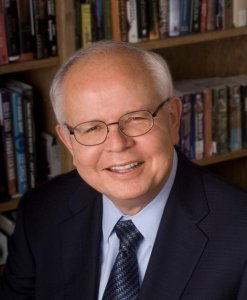
Harry Pachon, president and chief executive officer, Tomas Rivera Policy Institute
“This project has been very valuable to Latino students and their parents in California, and now the positive impact will be nationwide,” said Harry Pachon, president and chief executive officer of the Tomas Rivera Policy Institute. “We are very excited about encouraging the pursuit of a higher education, about giving Latino students the information they need to help start and finish college by making it more affordable. We expect demand this year to surpass the pace set last year.”
As part of the project the Institute will mail 6,000 scholarship guides to guidance counselors at low-income schools in the five states with the largest Latino populations in the country, California, Florida, Illinois, New York, and Texas. Another 2,500 scholarship guides will be distributed to Latino students during The Sallie Mae Fund Paying for College Bus Tour. An additional 1,500 guides will be distributed to community based and direct service organizations such as The Mexican American Legal Defense Fund, Parent Institute for Quality Education, and the Hispanic Scholarship Fund.
Founded in 1985, the Tomas Rivera Policy Institute (TRPI) advances informed policy on key issues affecting Latino communities through research contributing to the betterment of the nation. TRPI is an affiliated research unit of the University of Southern California School of Policy, Planning, and Development and is associated with the Institute for Social and Economic Research and Policy at Columbia University.
Comments:
Filed Under: Books
Posted by Elena del Valle on October 4, 2007

Alexandra Galindez, director, multi-cultural marketing Burger King Corporation
Photo: Burger King Corporation, Hispanic Youth Foundation
In support of Hispanic heritage, Hispanic culture and National Youth Soccer Month, Burger King Corporation sponsored six Soccer Immersion programs in Los Angeles, Washington, D.C., Chicago, Dallas and Houston, reaching 150 Latino youth. The company’s support will continue in November with a free community-wide outdoor event in conjunction with the 2007 MLS Cup in Washington D.C.
As part of the promotion, Burger King aspiring athletes were able to compete in MLS ¡Futbolito!Tournaments. Numerous clinics and games were scheduled to raise awareness and educate the public about youth soccer as part of the Fifth Annual National Youth Soccer Month. Marketing staff at Burger King believe soccer has regained popularity during recent years among athletes because of the superstars that have joined the game and the “sport’s positive, character-building lessons.” The hamburger maker declined to share budget numbers or details about its efforts to reach Latino consumers.
“Burger King Corporation recognizes the importance of physical activity and team sports, like soccer, as part of a child’s healthy upbringing,” said Alexandra Galindez, director for multi-cultural marketing. “Our desire is to help young athletes further develop their soccer skills and passion for the game by providing them with unique opportunities to compete in tournaments and meet some of their sports heroes.”
“Latino Family Dynamics” audio recording


Brenda Hurley and Liria Barbosa
Discuss
- Latino purchasing habits and products they favor
- Latino family characteristics
- Latinos and extended families
- Division of duties, responsibilities within the family
- Who is the decision maker in the Latino family
- Who is the information provider in the Latino family
Click here to find out about Latino purchasing habits and “Latino Family Dynamics”
Burger King sponsored several soccer initiatives in conjunction with MLS W.O.R.K.S. Throughout the year, the company sponsored teams’ registration fees, uniforms and other soccer gear to facilitate Hispanic adult and youth teams in 14 cities to be part of the MLS ¡Futbolito! Tournament. Additionally, Burger King sponsored some youth and their chaperones from local community organizations with enhanced treatment that included special recognition at select SuperLiga games, reserved seating during the game, and access to post-game meet and greet opportunities with soccer celebrities.

Rick Castillo, board member, Hispanic Youth Foundation
“As the demographic landscape continues to grow and change, so do the needs of communities and the kids that live within them,” said Rick Castillo, board member, Hispanic Youth Foundation. Physical and economic restraints often limit the reach and development of youth and it is great to see that companies like Burger King Corporation are taking an initiative to reach out to organizations like the HYF. With the help of BKC and its resources, more opportunities are made available to local children.”
The Burger King system operates more than 11,200 restaurants in 50 states and 69 countries and U.S. territories worldwide. According to promotional materials, 90 percent of Burger King restaurants are owned and operated by independent franchisees. No information was available on the number of Hispanic owned franchises.
According to the Burger King website, the company supports the Hispanic Heritage Council, Hispanic Association on Corporate Responsibility (HACR), League of United Latin American Citizens (LULAC), National Council of La Raza (NCLR), and the U.S. Hispanic Chamber of Commerce (USHCC). Since 1989, Bromley Communications has been the company’s agency of record for Hispanic market issues. The Hispanic Youth Foundation (HYF), a nonprofit organization, funds educational programs and other initiatives for at-risk Hispanic children and youth.
Posted by Elena del Valle on October 3, 2007
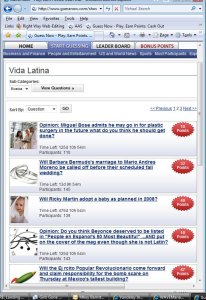
Click on image to enlarge
Photo: GuessNow.com
Predictive website GuessNow.com added a new category, Vida Latina, on Latino culture topics to its pages. The new section allows GuessNow members to guess the outcome of future Hispanic market events, in English. The website tests subscribers’ predicting skills and rewards them with points which can be converted into money.
Florida based GuessNow launched the Latin category recently to increase Latino visitor traffic to its website. Executives see English speaking Latino consumers as such an essential market in the prediction arena and their website that they are spending 30 percent of their budget to market to Latinos.
“GuessNow.com will continuously fill their Vida Latina section with questions relevant to the Latin market. The company knows the importance U.S Hispanics give to events related to their ethnic group whether is politics, entertainment or business related so creating a category solely dedicated to these group is for sure the best way to attract the fastest growing minority group in the country,” said Gabriela Nunez on behalf of GuessNow.
Guessnow.com entices subscribers to participate within 15 seconds of logging on by providing short multiple choice questions about the possible outcome of upcoming events. In addition to Vida Latina, Guessnow.com categories include business, finance, people, entertainment, sports, news, and politics.
“Segmentation by Level of Acculturation” audio recording

Presenter Miguel Gomez Winebrenner
Discusses
- Assimilation versus acculturation
- Factors that affect Latino acculturation
- How to know if someone is acculturated
- Number of years necessary for acculturation
- Effects of immigration debate on acculturation
- Three main ways of segmenting Latinos
Click here for details about “Segmentation by Level of Acculturation”
“Prediction markets fundamentally work on the wisdom of crowds,” said John Ferber, chief executive officer, Guessnow.com. “We are taking the concept of predictive markets to the masses, including the Latin community. The Internet makes it possible for anyone’s prediction to be known. We want every person’s voice to be heard which helps shape our future.”
Website promoters believe the site will draw people seeking clues on how to advance their business objectives, invest their money, pick winners in sports, choose winning stocks and who will win the 2007 Latin Grammy Awards. Common questions include: Why would you buy a Hybrid car? Will the print news media become obsolete within the next five years? Are the new music videos trivializing the political races? Do you think that immigrants that are in the U.S. illegally should have the right to stay in the U.S.?
Some of the questions in the Vida Latina section include: At this year’s Los Premios MTV Latin America, which artist will receive the Video of the Year Award? Who will be the Best Independent Artist at Los Premios MTV Latin America awards? Which Urban Artist will win the award at Los Premios MTV Latin America? At this year’s Los Premios MTV Latin America, which artist will receive the MTV Tr3’s Best New Artist Award?
Established in July 2007, GuessNow is owned by Vandelay Industries and managed by Ferber, described as the creator of Advertising.com; as well as Jason Ellin as chief financial officer, Erik Simons in business development, Jason Boshoff as chief operating officer, and Nicole Hollander in marketing and business development. Just 60 days after the GuessNow website was launched it reported 15,000 users.
Posted by Elena del Valle on October 2, 2007
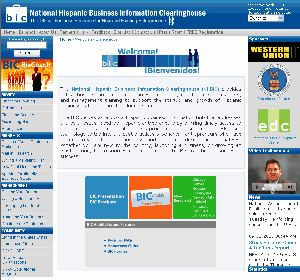
Click on image to enlarge
The National Hispanic Business Information Clearinghouse (NHBIC) launched a website, NHBIC.org, designed to provide information for minority entrepreneurs wanting to start their own businesses. The project was funded by a $3.3 million grant from the U.S. Department of Labor and start-up capital from Denver-based Western Union.
Western Union will also assist in publicizing the program to small business owners and merchants through its network of 50,000 U.S. agent locations. The Latino Coalition and other national, state and local groups, as well as community and faith-based organizations, also plan to promote NHBIC to their members.
Western Union’s “ethic of empowering our consumers to achieve sustainable economic stability. These BICs, when available in multiple languages, will reach millions of immigrants and minorities with information to start, grow and maintain successful businesses in the U. S. The rewards will be felt nationwide,” said Fred Niehaus, senior vice president of public affairs for Western Union, of his company’s interest in supporting NHBIC.
Site organizers promise bilingual information on how to finance, manage and market a new or existing business. The website is published in English and Spanish and is expected to include other languages and ethnic groups in the future.
“The NHBIC website focuses on the three m’s of business, money, markets and & management. It empowers aspiring business owners by providing critical information on financing a business, selling products and services and running a company,” said Salvador Gomez, program project director, NHBIC. “As a bilingual resource, it will be especially useful for those who have traditionally been underserved because English is not their first language.”
“Best in Class Hispanic Strategies” audio recording


Presenters Carlos Santiago and Derene Allen
-
Find out what makes 25 percent of the top 500 Hispanic market advertisers out perform the remaining companies
-
Discover what questions to ask, steps to take to be a Best in Class companies
Click here to learn about “Best in Class Hispanic Strategies” audio recording
According to promotional materials, the NHBIC website includes pre-screened and categorized business-related content; a specialized and business-specific search engine; personalized user features; localized, culture-specific community resources; and updated news related to minority small businesses.
“The launch and operation of the National Hispanic Business Information Clearinghouse will have a tremendous ripple effect in Latino communities across the United States and the country as a whole,” said Hector Barreto, former administrator of the U. S. Small Business Administration. “Small businesses are the engine of our nation’s economy, and this program encourages and supports entrepreneurial success and is to be commended.”
The NHBIC website will be the organization’s first in a series of online portals providing members of emerging markets basic tools to start a business. Additional clearinghouses are planned in coming years for African-American, Asian and Native-American audiences. Organizers plan to offer business basics, legal requirements, licensing, permitting, accounting, employee management, paying taxes, marketing, sales and government contracting information to those groups.
Posted by Elena del Valle on October 1, 2007
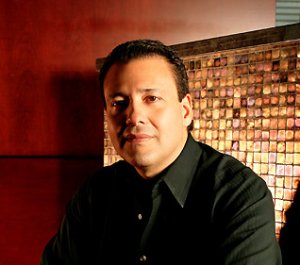

César M. Melgoza, managing director and senior partner, Latin Force and David Perez, CEO, Latin Force
Photos: Geoscape International, Latin Force
A podcast interview with Cesar Melgoza, managing director and senior partner, Latin Force LLC (at the time of the recording Cesar Melgoza was president of Geoscape International, Inc.) and David Perez, CEO, Latin Force LLC is available in the Podcast Section of Hispanic Marketing & Public Relations, HispanicMPR.com. During the podcast, they discuss the Hispanic Marketscape Overview and Latin Force with Elena del Valle, host of the HispanicMPR.com podcast.
Cesar has been an innovator in the development of market intelligence data, systems and analytic services. In 1995, he formed Geoscape International to focus on the application of marketing intelligence services, data and technology towards the multicultural and multinational markets. He led growth at Geoscape by developing products and services that provide geo-demographic, marketing and media data, predictive database modeling, and information enhancement systems. Most recently, he launched the Geoscape Intelligence System (GIS) and the DirecTarget system for database enrichment.
Cesar’s career is a blend of information technology and market research. While completing his undergraduate degree at the University of California, Santa Barbara he helped build computer hardware for Information Magnetics Corp. While earning his master’s degree in at the University of Texas at Austin, César was a research associate at one of the first Hispanic market research companies and also at the University’s Center for Mexican American Studies.
Listen to Cesar Melgoza discuss
“Changing Latino Landscape” audio recording

Presenter Cesar Melgoza, managing director, Latin Force Group
Find out about
• How demographic, social, political and economic factors affect Latinos
• Number of Hispanics in U.S.
• Hispanics as a percent of the mainstream population
• Number of Puerto Ricans in Puerto Rico
• Hispanics, including Puerto Rico, as a percent of U.S. mainstream
• Number of Asians and African Americans
• Estimated size of Hispanic market by 2012
• Percentage growth of new Hispanics per year
• Number of counties where Latinos are majority
• Areas of significant Latino growth
• Area of U.S. with a 950 percent Latino growth
• Role of acculturation
• Hispanicity segmentation
Click here for information on the Changing Latino Landscape
In the late 1980s, he developed and led desktop mapping and workgroup computing initiatives at Apple Computer in Cupertino, California. He went on to lead marketing and international business development at venture-funded Strategic Mapping, Inc. where he was instrumental in achieving annual revenue growth from $2 million to $35 million in four years. Born in Michoacán Mexico, Cesar grew up in California and has been a resident of various rural and urban population centers in the U.S.
David has worked with Kraft Foods, ING, MTV, Nike, Colgate-Palmolive, the National Football League, Neiman Marcus, Nickelodeon Networks, Cranium, Virgin Mobile, and Wells Fargo among others.
Before starting Latin Force, David was president and co-founder of Lumina Americas a Hispanic and Latin American integrated marketing company financed with $25 million of institutional private equity. He is former chairman of the Cultural Access Group, a leading multicultural market research firm since 1986.
David is co-founder of the New Generation Latino Consortium, a non-profit industry advocacy group and founder of Silverlining, a non-profit internet-based community for families of terminally ill children.
To listen to the interview, scroll down until you see “Podcast” on the right hand side, then select “HMPR Cesar Melgoza, David Perez” click on the play button below or download it to your iPod or MP3 player to listen on the go, in your car or at home. To download it, click on the arrow of the recording you wish to copy and save to disk. The podcast will remain listed in the October 2007 section of the podcast archive.
Click the button to hear the podcast:
Posted by Elena del Valle on September 28, 2007

RBD is Anahi, Dulce, Maite, Alfonso, Christian and Christopher
Photo: Terra
Latin pop band RBD, MTV Tr3s and Roptus joined efforts to promote the band’s “Tour Celestial 2007” in the United States. RBD’s U.S. tour, produced by Roptus, kicked off September 15, 2007 in San Juan, Puerto Rico and will end November 10 in Miami. After Puerto Rico it’s scheduled to stop in Chicago, Houston, San Antonio, Dallas, Phoenix, Sacramento, San Jose, Fresno, Los Angeles, and San Diego before closing in Miami.
On September 20, RBD was scheduled to perform its single “Besame Sin Miedo” and a surprise track during a special appearance on “Mi TRL.” On October 9, they will appear in “Tour-ismo,” sharing with fans an intimate side of RBD as the group members explore New Mexico, shop for vintage clothing, meet with Native Americans who explain the city’s celestial spirit, and ride low-riders before performing in concert.
“We are thrilled to bring MTV Tr3s viewers these unique connections to RBD,” said Michael Galbe, vice president, Music and Talent, MTV Tr3s. “Our sponsorship of RBD’s ‘Tour Celestial 2007’ connects MTV Tr3s viewers with one of the biggest selling Latin acts of the past several years and gives our viewers unique and exclusive access to RBD from exciting new programming to texting to live mega events.”
“Emotional Branding: How to capture the heart and mind of the Hispanic consumer” audio recording


“Emotional Branding” was recorded January 2007 during the Strategic Research Institute 13th Annual Blockbuster Marketing to U.S. Hispanic and Latin America conference in Miami, Florida. Receive a free downloadable copy by completing our Visitor Survey.
Click here for your free copy of Emotional Branding
RBD is Anahi, Dulce, Maite, Alfonso, Christian and Christopher. The group was born in 2004 from Mexican soap opera “Rebelde.” According to promotional materials, before arriving in the U.S., “Tour Celestial 2007” sold out venues in Brazil, Ecuador, Spain, Romania and Japan.
MTV Tr3s is a television network dedicated to bicultural Latino youth with a fusion of American and Latino music, cultures, lifestyles and languages. Music programming is at the core of MTV Tr3s and the channel features popular performers, emerging artists and new sounds. In addition to music programming, MTV Tr3s also features lifestyle series, news, and documentaries.
Roptus is an international marketing and concert production company that specializes in live entertainment marketing events for the Latin market. Roptus operates in 14 countries. Properties include the RBD 2006 and 2007 world tours, and active divisions in soccer and theater events in Los Angeles and Hollywood, California.
Posted by Elena del Valle on September 27, 2007
By Elena del Valle, MBA
Principal, LNA World Communications
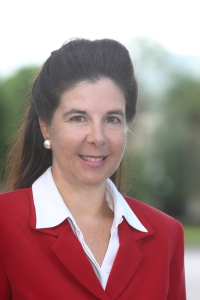
Elena del Valle, MBA, principal, LNA World Communications
Photo: Cristian Lazzari
Did you ever wonder what you said or did to annoy a Hispanic media representative? Why the story you were working on went to a competitor and your company was mentioned in a lesser light or, worse yet, ignored completely by Hispanic media? As you’re sitting at your desk in the aftermath of the proverbial storm wondering what went wrong consider some sure fire ways to be left out in the future.
Read the complete article Five tips to ensure Hispanic media don’t cover your story
“Latino Media and Hispanic Media Training” audio recording


Presenters Federico Subervi, Ph.D. and Elena del Valle, MBA
Find out
• About the hundreds of Latino media
• Who are the major Hispanic media
• Type of media outlets they represent
• Languages in which they are produced
• Programming and content they offer
• Hispanic media geographic reach
• Hispanic media challenges
Click here for information on Latino Media and Hispanic Media Training
Posted by Elena del Valle on September 26, 2007
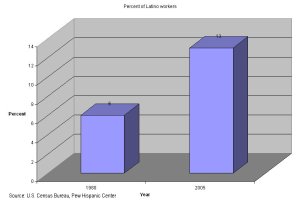
Click on image to enlarge
The number of Latino foreign workers and their earning ability increased over the last ten years. While foreign born workers represented 7 percent of the labor pool in 1980, by 2005, they represented 15 percent of workers. Latinos accounted for 13 percent of the total labor force in 2005, up from 6 percent in 1980.
At the same time, there were 1.2 million more Latino workers in 2005 than in 1995. Not only did the percent of Latinos in the labor force increase and the absolute number of Hispanic workers shoot up, their earning capacity improved.
According to a recently published report by the Pew Hispanic Center, foreign born Latinos earned more money per hour in 2005 than they did ten years earlier. Newly arrived Hispanics between those years also fared better, according to Rakesh Kochhar, associate director for Research, Pew Hispanic Center.
Target Latinos effectively by anticipating changes in the market with
“Hispanic Projections with 2007-08 update” audio recording

Presenter Roger Selbert, Ph.D.
Find out
- About Latino buying power growth in the future
- How Latino market growth compares with other markets in the U.S.
- What drives the rise of Latino economic clout
- Who should target the Latino market
- What is the size of the Hispanic affluent market
- If the luxury Latino market is growing
Stay ahead of your competion with “Hispanic Projections”
Kochhar concluded this is due to the arrival of better educated Latinos more likely to become employed in construction than in agriculture. At the same time that wage earning capacity of Latinos escalated to the middle of the range from the low end, wages for Asians jumped to the high end.The Pew report was based on the Census Bureau Current Population Survey, a monthly survey of 60,000 families. The report did not distinguish between documented and undocumented immigrants or the earning capacity of each group.
The Pew Hispanic Center, an initiative of the Pew Research Center, is a non-partisan, non-advocacy research organization based in Washington, D.C. The Pew Hispanic Center is funded by The Pew Charitable Trusts.



































